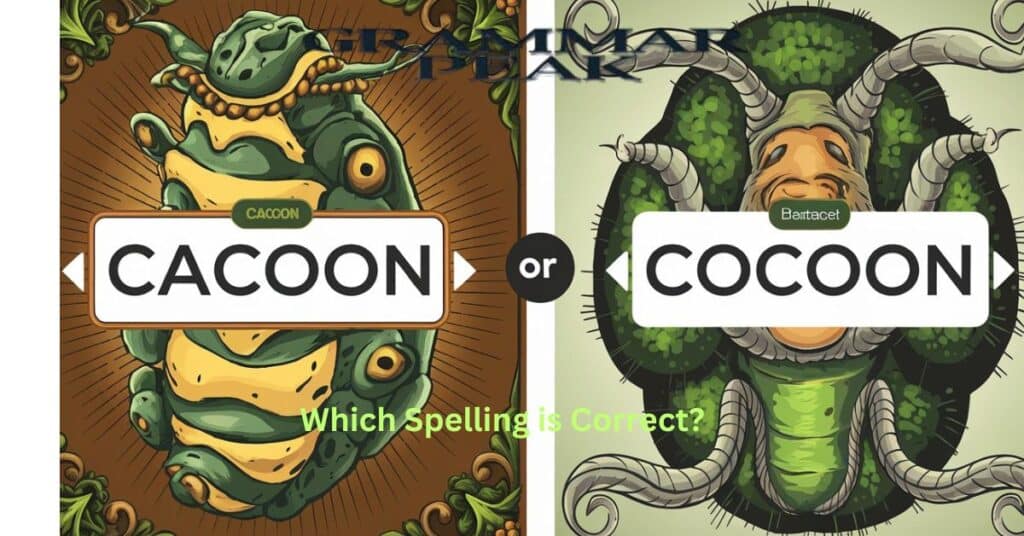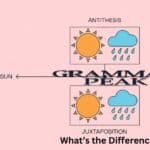Many times people ask which is the right spelling between the words “Cacoon” and “Cocoon,” thereby creating confusion because the words sound quite similar phonetically.
This article would help resolve the problem by explaining the difference between the two words, their meanings, and their origins. In the end, you will know exactly which one is correct and when to use “Cacoon” or “Cocoon.”
Why is There Confusion?
The confusion between “Cacoon” and “Cocoon” is quite common. Many people mispronounce or misspell these terms due to their similar sounds. This is especially true for those who are not familiar with the botanical term Cacoon.
The English spelling variations can also lead to misunderstandings. For instance, when people hear the word “cocoon,” they might mistakenly think of “cacoon” because of how it sounds.
Additionally, the cultural significance of beans and plants can add to the confusion. In some contexts, people might refer to the tropical bean Cacoon when discussing certain plants. This can lead to a mix-up with the more commonly known cocoon associated with insects. Understanding these nuances helps clarify why these terms are often confused..
Read more about Cacoon or Cocoon: Which Spelling is Correct?
What is a “Cacoon”?
A “Cacoon” refers to a specific type of plant, particularly the snuffbox bean plant known scientifically as Fevillea cordifolia. This plant is native to tropical regions and is recognized for its unique characteristics. The botanical context of “Cacoon” is essential for understanding its significance.
The tropical plants that fall under this category often have a rich history in traditional medicine and practices. They are known for their protective coverings, which can be likened to the protective casing of a cocoon. However, the term “Cacoon” is not widely used in everyday language, making it less familiar to many people.
What is a “Cocoon”?
In contrast, a “Cocoon” is a well-known term that describes the protective casing spun by certain insects, particularly during their metamorphic process. For example, the silkworm cocoon is famous for its role in silk production. This casing serves as a shelter for the insect during its pupal stage, allowing it to transform into its adult form.
The metaphorical use of cocoons extends beyond insects. It symbolizes comfort, isolation, and transformation in various contexts. For instance, people often refer to cocoon furniture and cocoon chairs as cozy designs that provide a sense of security and comfort. This dual meaning makes “Cocoon” a versatile term in both nature and culture.
| Term | Origin | Cultural Significance |
| Cacoon | Botanical | Traditional medicine |
| Cocoon | Latin | Silk production |
“Cacoon” vs “Cocoon”: The Differences
When comparing “Cacoon” and “Cocoon,” it is essential to understand their differences in spelling, meaning, and usage.
Spelling:
The spelling of “Cacoon” and “Cocoon” differ significantly.
first section
- The correct spelling of “Cocoon” is essential for clear communication.
- Many people mistakenly write “Cacoon” due to its phonetic similarity.
- Understanding this difference can help avoid misunderstandings in writing.
- The word “Cocoon” has two “o’s,” which is crucial to remember.
- In contrast, “Cacoon” is not a widely recognized term.
- Misspellings can lead to confusion, especially in academic or professional contexts.
- Using the correct spelling shows attention to detail and enhances credibility.
- The term “Cocoon” is commonly used in discussions about insects and their life cycles.
- It refers to the protective casing that many insects create during their metamorphosis.
- On the other hand, “Cacoon” is primarily associated with botanical discussions.
2nd section
- When writing, it’s important to ensure accuracy in spelling.
- Mispronounced or misspelled terms can detract from the intended message.
- The phonetic similarities between the two words can lead to errors.
- Remembering the correct spelling of “Cocoon” can improve your writing skills.
- Using “Cacoon” instead of “Cocoon” can confuse readers.
- Therefore, it’s essential to familiarize yourself with the proper usage.
- The significance of using the correct spelling should not be underestimated.
- It can affect how your message is received by the audience. In various contexts, the term “Cocoon” holds more familiarity.
- By using the correct spelling, you contribute to clearer communication.
- Ultimately, mastering these differences can enhance your overall language proficiency.
Meaning:
The meanings of “Cacoon” and “Cocoon” differ significantly.
First section
- “Cacoon” refers to a specific plant known as the snuffbox bean plant.
- This plant, scientifically named Fevillea cordifolia, is recognized for its unique properties.
- In traditional medicine, the Cacoon has historical significance due to its medicinal uses.
- On the other hand, “Cocoon” describes the protective casing spun by insects during their life cycle.
- The most common example of a cocoon is the silkworm cocoon, which is essential for silk production.
- The cocoon serves as a shelter during an insect’s metamorphosis.
- While Cacoon is primarily botanical, Cocoon has broader applications in literature and culture.
- The term “Cocoon” is often used metaphorically to represent comfort and transformation.
- Understanding these meanings helps clarify the context in which each term is used.
- Cacoon is rarely mentioned outside of specialized discussions about plants.
2nd section
- In contrast, Cocoon is widely recognized across various fields, including biology and design.
- Both terms highlight the concept of protection but in different ways.
- The Cacoon offers protection in a botanical sense, while the Cocoon does so in an ecological context.
- The meanings of these words reflect their origins and uses in different disciplines.
- Recognizing the distinction between Cacoon and Cocoon is crucial for effective communication.
- The metaphorical use of Cocoon conveys deeper meanings in literature and art.
- In summary, Cacoon is linked to a specific plant, while Cocoon encompasses a broader range of meanings.
- This difference in meaning is essential for understanding the language used in various contexts.
- Ultimately, knowing the meanings of these terms enriches one’s vocabulary.
- Clarity in communication is achieved by using the correct term based on its meaning.
Usage:
In everyday language, “Cocoon” is far more common than “Cacoon.”
First section
- It appears in various contexts, from nature to furniture design.
- For instance, you might hear about a silkworm cocoon in a biology class.
- Additionally, cocoon chairs are popular in modern interior design for their cozy feel.
- The term “Cocoon” is also used metaphorically to describe a state of comfort and protection.
- People often refer to a cocoon when discussing personal growth and transformation.
- In literature, the cocoon symbolizes a safe space for change.
- On the other hand, “Cacoon” is rarely used outside of botanical discussions.
- It is mostly found in texts that focus on specific plants, like the snuffbox bean plant.
- The usage of “Cacoon” is limited, making it less familiar to the general public.
- In academic writing, using the correct term is crucial for clarity.
2nd section
- Misusing “Cacoon” instead of “Cocoon” can confuse readers.
- Therefore, understanding the context is vital for effective communication.
- Many people may not encounter “Cacoon” unless they study botany.
- In contrast, “Cocoon” is a term that most people recognize.
- It is frequently used in discussions about insects and their life cycles.
- The versatility of “Cocoon” allows it to fit into various topics.
- This makes it a more useful term in everyday conversations.
- Overall, the usage of these terms highlights the importance of context.
- Knowing when to use “Cacoon” or “Cocoon” can enhance your communication skills.
- Ultimately, using the correct term based on its context is essential for clear understanding.
| Term | Correct Spelling | Common Misspelling |
| Cacoon | Cacoon | Cocoon |
| Cocoon | Cocoon | Cacoon |
Examples of “Cacoon” and “Cocoon” in Context
To illustrate the differences between “Cacoon” and “Cocoon,” let’s look at examples of each term in context.
“Cacoon” in Context:
The “Cacoon” is a term that is primarily used in botanical contexts.
First point
- The tropical bean Cacoon is known for its medicinal properties.
- Traditional healers often use the leaves of the snuffbox bean plant, also known as Fevillea cordifolia, in their remedies.
- The Cacoon is a large bean that comes from a tropical climber plant.
- This plant has been used for centuries to make various items, such as purses, spoons, and snuffboxes.
- In Jamaica, the Cacoon plant is also referred to as the “cacoon vine.”
- The Cacoon is not a widely recognized term outside of specialized botanical discussions.
- It is primarily associated with the specific plant species and its traditional uses.
- The Cacoon is not as commonly used as the term “Cocoon,” which has a broader range of applications.
- While the Cacoon is significant in certain cultural and medicinal practices, it is not a term that is frequently encountered in everyday language.
- In the context of traditional medicine and botany, the Cacoon holds important cultural and historical significance.
2nd point
- However, its usage is limited to these specialized fields.
- Individuals who are not familiar with the botanical context may not recognize the term “Cacoon.”
- In contrast, the term “Cocoon” is much more widely known and used in various contexts.
- The Cacoon is a unique and fascinating plant, but its usage is primarily confined to specific discussions about its botanical and medicinal properties.
- Understanding the context in which the term “Cacoon” is used is essential for effective communication.
- In everyday language, the more commonly recognized term “Cocoon” is more likely to be understood.
- The Cacoon is a specialized term that is not as widely known or used outside of its botanical context.
- Recognizing the distinction between the “Cacoon” and the “Cocoon” is crucial for clear and accurate communication.
- The Cacoon represents a unique and culturally significant plant, but its usage is primarily limited to specific fields of study.
- Knowing the appropriate context for using the term “Cacoon” can enhance one’s understanding of botanical and traditional medicinal practices.
Cocoon in Context:
The term “Cocoon” is widely recognized in various contexts, especially in nature.
First point
- The silkworm cocoon is a vital part of silk production.
- Farmers carefully harvest these cocoons to create beautiful silk fabrics.
- Each cocoon is made from silk produced by the silkworm as it undergoes its metamorphosis.
- The process of silk production involves boiling the cocoons to extract the silk threads.
- The cocoon serves as a protective casing for the insect during its pupal stage.
- In nature, many insects, not just silkworms, create cocoons for protection.
- The cocoon symbolizes transformation and growth in literature and art.
- People often use the term “Cocoon” metaphorically to describe a safe space for personal development.
- For example, someone might say they are in a cocoon of comfort during challenging times.
- In modern design, cocoon chairs are popular for their cozy and inviting shapes.
2nd point
- These chairs are designed to provide a sense of security and relaxation.
- The concept of a cocoon extends to emotional and psychological contexts as well.
- Many self-help books discuss the idea of creating a cocoon for personal growth.
- In biology, understanding the role of a cocoon helps explain the life cycle of various insects.
- The cocoon is often studied in entomology to learn about insect behavior.
- Artists frequently draw inspiration from the cocoon as a symbol of change and resilience.
- The cocoon provides a protective barrier until the insect is ready to emerge as an adult.
- This natural phenomenon fascinates scientists and nature enthusiasts alike.
- In summary, the cocoon holds significance in both ecological and cultural contexts.
- Its multifaceted meaning enhances our understanding of transformation and protection in various aspects of life.
These examples show how each term is used in different contexts, highlighting their unique meanings.
Tables
| Term | Definition | Context of Use |
| Cacoon | A botanical term for the snuffbox bean plant | Traditional medicine |
| Cocoon | Protective casing of insects | Nature, literature, furniture |
Origins of “Cacoon” and “Cocoon”
The origins of “Cacoon” and “Cocoon” provide insight into their meanings and uses.
Origins of “Cacoon”:
The origins of “Cacoon” trace back to the Latin word “cucullus,” meaning “hood” or “cover.” This term reflects the plant’s protective features, particularly associated with the snuffbox bean plant. Fevillea cordifolia is the scientific name for the Cacoon plant, highlighting its botanical significance.
Historically, it has been used in traditional medicine, particularly in Caribbean cultures. The word has remained largely within botanical discussions, making it less familiar to the general public. Unlike the more commonly known “Cocoon,” “Cacoon” emphasizes the unique relationship between language and local flora.
Origins of “Cocoon”:
The term “Cocoon” originates from the Latin word “cucullus,” which means “hood” or “cover.” This reflects the protective nature of cocoons in the insect world, particularly for silkworms.
The word has evolved through various languages, maintaining its association with transformation and protection. In nature, cocoons serve as a vital stage in the life cycle of many insects, facilitating their metamorphosis.
Understanding these origins helps clarify the meanings of both terms.
FAQ” S
What is the correct spelling of the word?
The correct spelling is “Cocoon.”
What does “Cacoon” refer to?
“Cacoon” refers to the snuffbox bean plant.
What is a cocoon?
A cocoon is a protective casing spun by insects during their metamorphosis.
Why do people confuse these terms?
The phonetic similarity between words leads to confusion.
Can “Cocoon” be used metaphorically?
Yes, “Cocoon” is often used to symbolize comfort and transformation.
Conclusion
In conclusion, the correct spelling of “Cacoon” and “Cocoon” is essential for clear communication. While “Cacoon” refers to a specific plant, “Cocoon” describes the protective casing of insects. By understanding the differences between these terms, you can avoid confusion and use them correctly in your writing and conversations. Remember, the next time you encounter these words, think about their meanings and origins to choose the right one.

Mason Blake is an experienced blogger with a passion for language and communication. With years of expertise in crafting informative and engaging content, Mason shares valuable insights on grammar and writing. His clear, concise, and reader-friendly approach has earned him a loyal following, helping readers sharpen their language skills and master the art of effective communication.








Your point of view caught my eye and was very interesting. Thanks. I have a question for you.
I don’t think the title of your article matches the content lol. Just kidding, mainly because I had some doubts after reading the article.
Your article helped me a lot, is there any more related content? Thanks!
Can you be more specific about the content of your article? After reading it, I still have some doubts. Hope you can help me.
Your article helped me a lot, is there any more related content? Thanks!
Your point of view caught my eye and was very interesting. Thanks. I have a question for you.
https://t.me/s/TgGo1WIN/16
Thanks for sharing. I read many of your blog posts, cool, your blog is very good.
Thank you for your sharing. I am worried that I lack creative ideas. It is your article that makes me full of hope. Thank you. But, I have a question, can you help me?
Официальный Telegram канал 1win Casinо. Казинo и ставки от 1вин. Фриспины, актуальное зеркало официального сайта 1 win. Регистрируйся в ван вин, соверши вход в один вин, получай бонус используя промокод и начните играть на реальные деньги.
https://t.me/s/Official_1win_kanal/3261
Thank you for your sharing. I am worried that I lack creative ideas. It is your article that makes me full of hope. Thank you. But, I have a question, can you help me?
Your point of view caught my eye and was very interesting. Thanks. I have a question for you. https://accounts.binance.com/register?ref=P9L9FQKY
Your point of view caught my eye and was very interesting. Thanks. I have a question for you. https://www.binance.com/de-CH/register?ref=UM6SMJM3
Your point of view caught my eye and was very interesting. Thanks. I have a question for you.
What a great resource. I’ll be referring back to this often.
This topic is usually confusing, but you made it simple to understand.
Thanks for sharing. I read many of your blog posts, cool, your blog is very good.
oi0r2d
Thanks for sharing. I read many of your blog posts, cool, your blog is very good.
qyjh9v